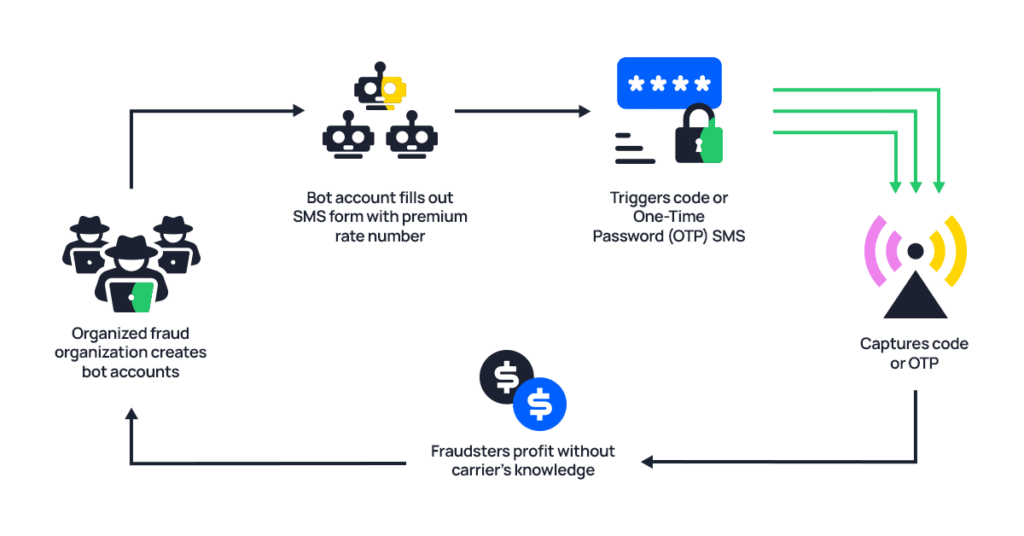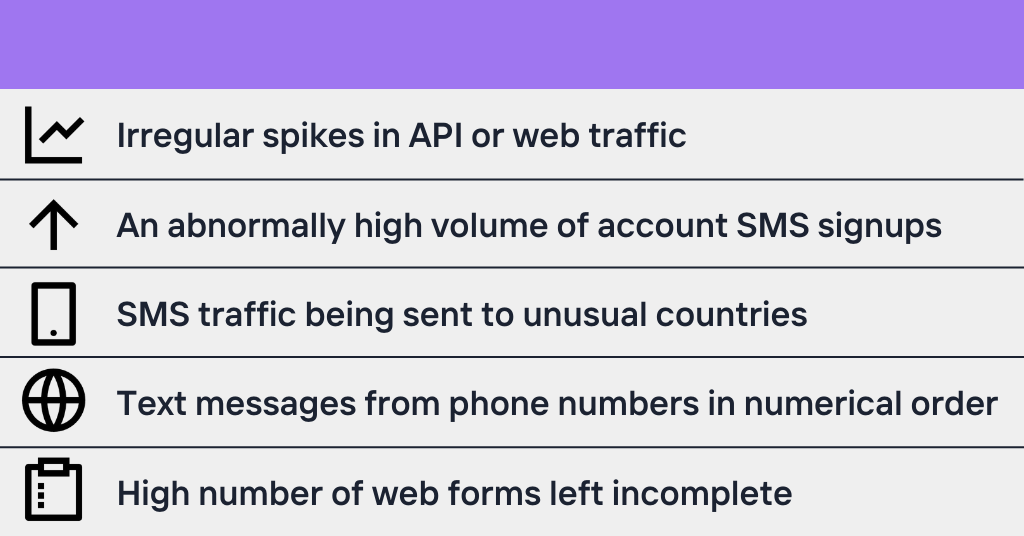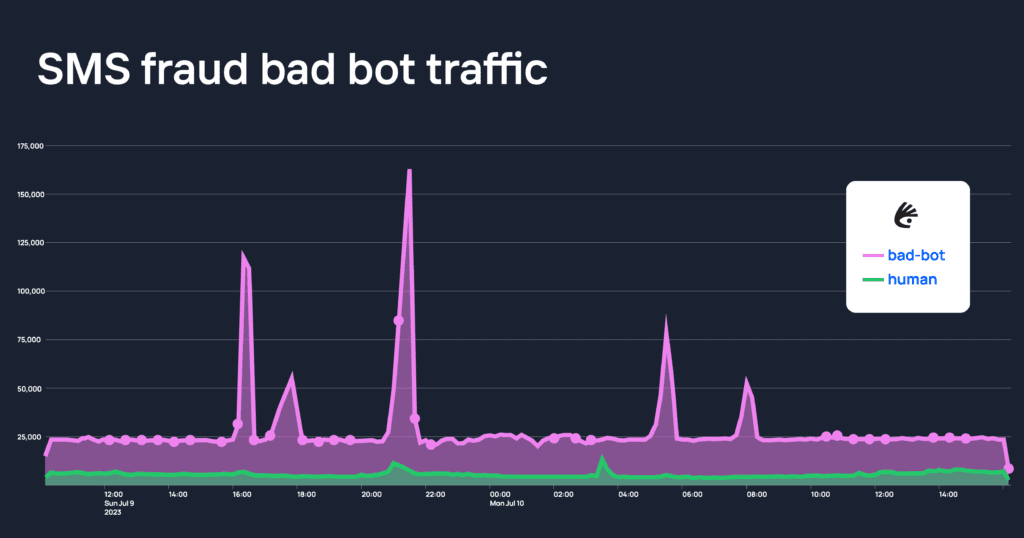As we navigate the digital landscape of 2023, businesses face a myriad of challenges. One that stands out for its potential to inflict significant financial damage is toll fraud. Affecting companies globally, SMS toll fraud and SMS pumping involves leveraging automation to generate revenue through SMS fraud.
Short Summary
- SMS toll fraud is a global issue that causes financial losses and disrupts operations.
- SMS toll fraud is often difficult to detect, highlighting the need for a robust security stack
- Implementing a modern bot mitigation security solution can help stop the automation used to conduct attacks.
Understanding the Impact of SMS Toll Fraud and SMS Pumping
SMS toll fraud is a form of fraudulent activity where attackers trick users into sending or receiving premium texts with exorbitant fees. The unsuspecting victims fall prey to these fraudulent premium services, while targeted businesses bear the cost.
SMS pumping occurs when attackers target businesses with SMS flows and flood SMS messages to controlled premium rate numbers. Traditionally attackers will share the inflated charges’ revenue with wireless carriers or mobile network operators. Targeted businesses end up footing the huge bill.
The impact of SMS toll fraud and SMS pumping on businesses can be staggering. Besides the immediate financial losses, companies often grapple with disrupted operations, dissatisfied customers, and a tarnished reputation. The most alarming aspect is that most businesses are not even aware they’ve fallen victim until they are charged by the wireless carriers.

Automation and SMS Toll Fraud
Attackers looking to carry out either SMS toll fraud or SMS pumping need to launch their attacks at scale. Fraudsters need a way to generate massive amounts of SMS messages from different phone numbers in order to turn a profit. This is why attackers leverage bad bots. Malicious automation provides adversaries with a highly sophisticated tool that is cheap, easy to use, and highly effective at evading detection. Without bad bots, attackers would not be able to profitably conduct toll fraud at scale.
The Growing Problem
SMS toll fraud is not a static problem. It’s evolving and growing, becoming increasingly common, and resulting in significant losses worldwide. SMS toll fraud and SMS pumping is having a real impact on brands. Recently, Twitter discovered they were a victim of SMS toll fraud, being charged $60 million per year due to 2FA SMS messages generated by fraudsters. This affects the revenue generated by businesses, leading to disrupted operations, and potentially causing significant damage to the company’s reputation.

Signs of a Potential SMS Toll Fraud Attack
Preventing SMS toll fraud and SMS pumping isn’t just about implementing security measures, but also about monitoring and detecting potential threats.
SMS toll fraud and SMS pumping can be hard to detect on your own, but there are some red flags that organizations can look out for to see if your organization is being targeted by toll fraud or SMS pumping attacks:

What an SMS Toll fraud attack can look like:

Implementing Bot Mitigation to Prevent SMS Toll Fraud Attack
Targeting and stopping the malicious automation behind SMS toll fraud and SMS pumping.
While the threat of SMS toll fraud looms large, the good news is that utilizing a modern bot mitigation solution can help prevent attacks. An effective bot mitigation solution will not only detect and stop bots attempting to carry out SMS toll fraud and SMS pumping attacks, it will also target the humans behind the attacks. Protecting your business from bot attacks both now and in the future.
How Does Modern Bot Mitigation Prevent Toll Fraud and SMS Pumping
Detection
Detecting the automation being used to carry out SMS toll fraud and SMS pumping attacks at scale is the first step in stopping them.
Traditional solutions leverage outdated detection methods like CAPTCHAs, rate limiting, behavioral analysis, or device fingerprinting. While these methods have worked in the past, bot operators have worked together to hone their skills and share their technology in order to evolve the automation used to launch their attacks. Bots can now easily feed faked data and solve CAPTCHA allowing them to look and act like humans more than ever before.
Kasada takes a different approach to bot detection. Our solution leverages hundreds of sophisticated sensors to detect the immutable evidence of automation that can’t be hidden during attacks.
Long-term Efficacy
Detection alone is not enough to stop sophisticated and motivated attackers. In order for a solution to remain effective it needs to take aim at the human behind the keyboard. SMS toll fraud and SMS Pumping is an extremely lucrative form of attack. Botters can essentially print money if their bots are able to abuse a business’ SMS flow.
Because of the financial incentives behind SMS toll fraud and SMS pumping, businesses need a solution that can remain effective in the face of reverse engineering and retooling attempts. A solution that stands still won’t last against motivated attackers. Bot operators will work to reverse engineer defense as long as the reward of a successful attack is worth their time. Traditional solutions make the decision to invest time into reverse engineering easy. These legacy solutions take months to adapt, giving botters plenty of time to create a bypass and launch successful attacks. In fact some adversaries are selling bypasses to traditional anti-bot solutions for less than $2 per 1000 bypasses, through solver services and CAPTCHA solvers.
Demotivating Attackers
Luckily an effective solution can use attackers’ financial motivation against them. Kasada’s solution uses a highly obfuscated virtual machine. Making reverse engineering incredibly difficult and time consuming, while forcing real-time execution of code. The Kasada platform is constantly changing the way it presents its code to adversaries. If in the event an attacker ever learns how Kasada’s defenses work, Kasada’s dynamic nature will require attackers to start again from scratch. This combination deters attackers and motivates them to move on from targeting your SMS flows as other companies can be targeted much more easily.

Summary
SMS toll fraud is a significant problem that businesses worldwide grapple with. However, with a comprehensive understanding of the issue, identifying the signs of attacks and the implementation of robust security measures can help protect your business.
As we’ve seen, SMS toll fraud is not a static problem, but an evolving one, highlighting the need for agile security partners that can keep pace with constantly changing attackers.
See how Kasada was able to save two of our Fortune 100 customers $8 million annually by stopping bots that were driving up chargebacks, SMS verification fees, and infrastructure costs.
If you are ready to work with a partner that takes ownership of its solution, eliminating the need to pay expensive professional service fees or maintain the solution yourself. Schedule a call and see how we can stop bots from conducting SMS toll fraud and SMS pumping attacks on your online channels.
Frequently Asked Questions
How can we stop SMS toll fraud?
Modern anti-bot solutions can stop the automation used by attackers to conduct SMS toll fraud at scale.
How does SMS toll fraud work?
SMS toll fraud involves tricking users into sending or receiving premium texts with exorbitant fees. The unsuspecting victims fall prey to these fraudulent premium services, while targeted businesses bear the cost.
Premium rate number fraud involves increasing the number of calls to a premium number in order to increase revenue, as well as call selling fraud.
Call selling fraud involves selling calls to a premium rate number at a discounted rate, which can result in a loss of revenue for the premium rate number provider.
What are some examples of businesses that have successfully prevented SMS toll fraud?
Kasada protects its customers by stopping the malicious automation used to conduct SMS toll fraud at scale. One of Kasada’s Fortune 100 customers was able to save $5.6 million in SMS charges by blocking bots conducting SMS toll fraud.





